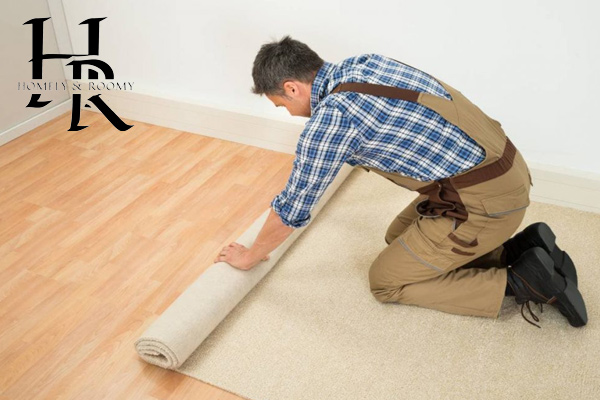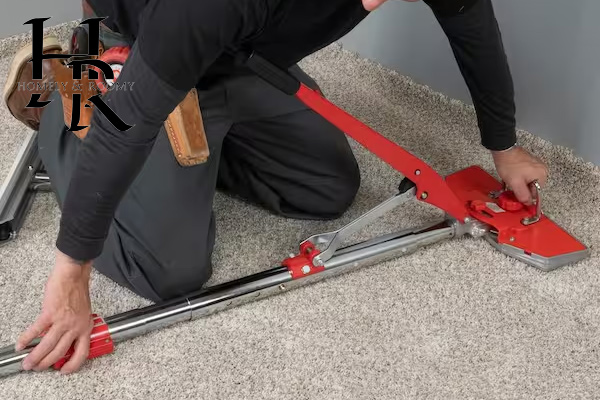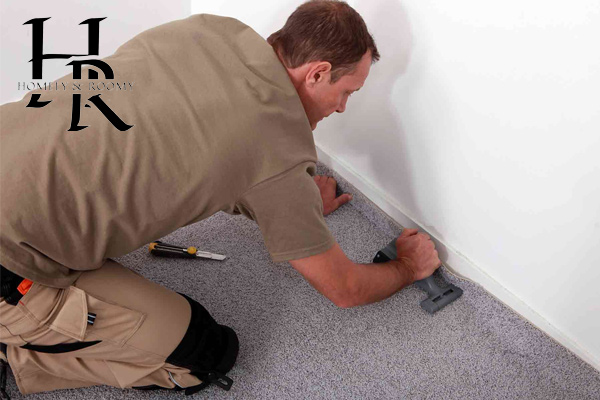Blog
Can Carpet Be Stretched Without Moving Furniture?
Carpet stretching is a common maintenance task aimed at maintaining a smooth and safe surface. Many homeowners wonder, “can carpet be stretched without moving furniture?” This article will address this concern, providing insights into the process and potential solutions for stretching carpets without the hassle of moving heavy furniture.

Key Takeaways by Can Carpet Be Stretched Without Moving Furniture
- Carpet stretching is essential to maintain a smooth and safe surface.
- It is possible to stretch carpet without moving all furniture.
- Techniques and tools can facilitate stretching around heavy furniture.
- Professional help is often recommended for best results.
Understanding Carpet Stretching
What is Carpet Stretching?
Carpet stretching involves pulling the carpet tight and securing it to ensure a flat and even surface. This process is essential for both the appearance and safety of your home. A well-stretched carpet not only looks better but also reduces the risk of trips and falls.
Common Causes for Needing Carpet Stretching

Several factors can necessitate carpet stretching. Over time, carpets can become loose due to regular wear and tear, improper installation, or heavy foot traffic. These issues lead to unsightly wrinkles and bumps, which can be both a visual and physical hazard.
Importance of Carpet Stretching
Maintaining a smooth carpet surface is crucial for both aesthetic and safety reasons. Regular carpet stretching helps prolong the life of your carpet, keeps your home looking neat, and prevents accidents caused by tripping over loose carpet sections.
Can Carpet Be Stretched Without Moving Furniture?
Challenges of Stretching Carpet with Furniture
Stretching carpet with furniture in place presents several challenges. The primary difficulty is accessing the carpet underneath and around the furniture. Heavy furniture can create obstacles, making it hard to achieve an even stretch. Additionally, there is a risk of damaging the furniture or the carpet during the process. Limited access can also prevent the use of certain tools, complicating the task further.
Situations Where It Might Be Possible
While stretching carpet with all furniture in place is challenging, it is not impossible. Here are some scenarios where minimal or no furniture movement is required:
- Lightweight Furniture: Items such as small tables, chairs, or decorative pieces can often be worked around. These items are easy to move temporarily if needed, or the carpet can be stretched around them without significant difficulty.
- Furniture on Wheels: Pieces of furniture with wheels, like office chairs or rolling carts, can be easily maneuvered to allow for carpet stretching without much hassle.
- Minimal Movement Required: In some cases, shifting furniture slightly to one side of the room can create enough space for stretching. Once one section is done, the furniture can be moved back, and the remaining area can be addressed.
- Using Specialized Tools: Professionals often have access to specialized tools that can stretch carpet in tight spaces. These tools allow for precise stretching without the need to move heavy furniture.
Professional Help
For the best results, it is recommended to hire a professional carpet installer or cleaner. Professionals have the experience and tools necessary to stretch carpet effectively, even in challenging situations. They can handle heavy furniture and ensure that the carpet is stretched evenly, avoiding damage to both the carpet and the furniture.
Techniques for Stretching Carpet Without Moving Furniture

Using Specialized Tools
Power Stretchers and Knee Kickers
Power stretchers and knee kickers are essential tools for carpet stretching.
- How They Work:
- Power Stretchers: These tools have a long handle and a head with gripping teeth. The power stretcher pulls the carpet tight by pushing against the opposite wall, ensuring a smooth, even stretch.
- Knee Kickers: Knee kickers are smaller tools with a padded end that you push with your knee. They are used for stretching carpet in tight spaces and for securing the carpet near walls.
- Benefits:
- Power Stretchers: Provide a strong, uniform stretch across the carpet, ideal for large areas.
- Knee Kickers: Perfect for detail work and stretching in confined areas where power stretchers can’t reach.
Furniture Sliders and Lifters
Furniture sliders and lifters are practical tools for moving heavy furniture with minimal effort.
- How They Help:
- Sliders: These are placed under furniture legs to reduce friction, allowing you to slide heavy items without lifting them.
- Lifters: These devices help lift one side of the furniture just enough to place sliders underneath.
- Tips for Effective Use:
- Use sliders on clean, flat surfaces to avoid damage to the carpet.
- Lift furniture carefully to prevent injury and ensure it’s adequately supported.
Strategic Stretching Methods
Stretching in Sections:
Stretching carpet in sections is an effective method when dealing with immovable furniture.
- The Method:
- Divide the room into manageable sections.
- Stretch and secure one section at a time, working around the furniture.
- Managing Around Furniture:
- Move lightweight furniture to create space for stretching.
- Use sliders to shift heavier pieces slightly to access the carpet underneath.
Temporary Lifting of Furniture:
Temporarily lifting furniture can make stretching easier without complete removal.
- The Process:
- Use furniture lifters to raise the furniture slightly.
- Insert sliders or blocks to keep the furniture elevated while stretching.
- Tools and Techniques:
- Utilize hydraulic lifters for heavy furniture.
- Ensure furniture is stable and supported to prevent accidents.
Professional Carpet Stretching Services
When to Consider Professional Help:
Hiring professionals can offer several advantages.
- Benefits:
- Expertise in handling complex stretching tasks.
- Access to advanced tools and techniques.
- What to Expect:
- Professionals will assess your carpet’s condition, provide an estimate, and carry out the stretching efficiently.
Cost and Time Considerations:
Professional services come with costs, but they may save time and effort.
- Cost:
- Professional carpet stretching can vary in price depending on room size and complexity, typically ranging from $100 to $300.
- Time:
- Professionals can complete the job more quickly than DIY methods.
- Comparison:
- DIY Methods: Less expensive but require time, effort, and the right tools.
- Professional Services: More costly but offer convenience, expertise, and quicker results.
Preparing for Carpet Stretching

Initial Assessment
How to Assess If Your Carpet Needs Stretching:
- Look for visible wrinkles, bumps, or loose areas in the carpet.
- Check for uneven surfaces that may indicate slack carpet.
Identifying Areas of Concern and Planning:
- Mark areas that need stretching.
- Plan the stretching process, considering furniture placement and room layout.
Gathering Necessary Tools and Supplies
List of Tools and Supplies:
- Power stretcher
- Knee kicker
- Carpet cutter
- Carpet tucker
- Furniture sliders
- Furniture lifters
- Measuring tape
- Utility knife
- Seam roller
Where to Acquire or Rent These Tools:
- Local hardware stores
- Home improvement centers
- Tool rental companies
Proper preparation and the right tools are crucial for successful carpet stretching. Assessing your carpet’s condition and planning the process can ensure a smooth, efficient job, whether you choose to do it yourself or hire professionals.
Step-by-Step Guide to Stretching Carpet Without Moving Furniture
Step 1: Clear the Area
How to Clear the Area:
- Begin by removing small items such as lamps, books, and decor from the carpeted area.
- Use furniture sliders to slightly move larger pieces of furniture out of the way without lifting them completely. This can create enough space for stretching the carpet without major rearrangements.
Tips for Organizing and Protecting Items:
- Place small items in boxes or bins to keep them organized and out of the way.
- Use protective covers on furniture that remains in the room to shield them from dust and potential damage during the stretching process.
Step 2: Prepare the Carpet
How to Detach the Carpet from the Tack Strips:
- Begin at one corner of the room, using a pair of pliers to gently lift the carpet from the tack strips.
- Carefully work your way around the perimeter, ensuring not to damage the carpet backing.
Preparing the Carpet for Stretching:
- Once the carpet is detached, check the padding underneath for any issues and replace it if necessary.
- Vacuum the carpet and padding to remove any dust and debris, ensuring a clean surface for stretching.
Step 3: Stretch the Carpet

Using Power Stretchers and Knee Kickers:
- Position the power stretcher against the opposite wall from where you started detaching the carpet.
- Extend the stretcher’s handle to create tension in the carpet, ensuring it pulls tightly and evenly.
Techniques for Achieving a Tight Stretch:
- Use knee kickers to fine-tune the stretch, especially near walls and corners. Place the kicker about 3 inches from the wall and use your knee to apply force, ensuring the carpet is tight.
- Work in small sections, moving the stretcher and kicker methodically around the room to achieve an even stretch.
Step 4: Reattach the Carpet
How to Reattach the Carpet to the Tack Strips:
- Starting at one corner, press the carpet back onto the tack strips using a carpet tucker or a blunt tool to secure it firmly.
- Continue around the room, ensuring the carpet is tightly secured to all tack strips.
Ensuring a Smooth and Secure Finish:
- Trim any excess carpet using a utility knife, being careful to leave enough to tuck under the baseboards for a neat finish.
- Use a seam roller to press the edges and seams, ensuring a smooth and professional look.
FAQs on Can Carpet Be Stretched Without Moving Furniture
Not all carpets are suitable for stretching. While most residential carpets can be stretched, some types like woven carpets and certain glued-down carpets may not stretch as easily or effectively. Always check the manufacturer’s guidelines for your specific carpet type.
Carpet typically needs stretching every 5-10 years, depending on usage and wear. High-traffic areas may require more frequent stretching to maintain a smooth surface.
Stretching older carpet can be worthwhile if the carpet is still in good condition overall. However, if the carpet is heavily worn, stained, or damaged, replacement might be a better option to ensure long-term durability and appearance.
If wrinkles reappear after stretching, it may indicate an underlying issue such as improper installation or subfloor problems. In such cases, it’s best to consult a professional to assess and correct the problem.


